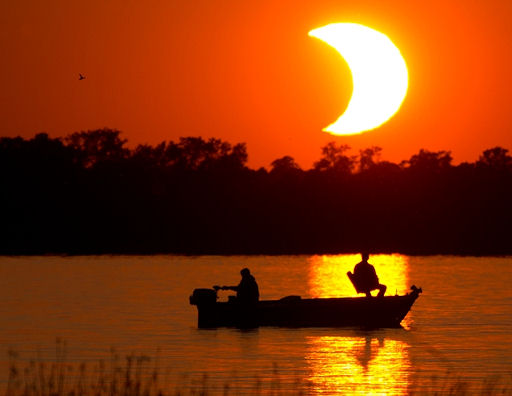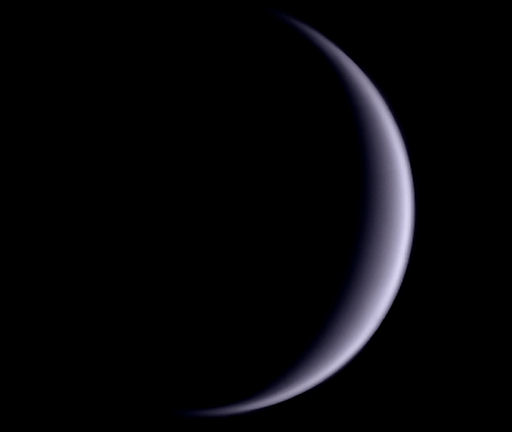Listen to radar echoes from satellites and meteors, live on listener-supported Space Weather Radio. | | | INTERPLANETARY SHOCK WAVE: An interpanetary shock wave possibly associated with the M5-class solar flare of May 17th swept past Earth on May 20th around 0200 UT. The shock's arrival caused geomagnetic activity around the poles, and several outbreaks of high-latitude auroras. Images: #1, #2. FANTASTIC ECLIPSE: The Moon passed in front of the sun on Sunday, May 20th, producing a deep solar eclipse visible across the Pacific side of Earth. Sunlight dimmed, the air cooled, ordinary sunbeams turned into fat crescents and rings of light. Here is a sample view from Lake Waconia, Minnesota: 
"I drove to the lake, and a couple of fishermen were kind enough to drop their lines in the glitter path of the eclipse," says photographer Tyler Burg. "It was a fantastic composition!" NEW: Space Weather Real Time Image Gallery more images: from Mike Theiss of New Mexico; from Sze-leung Cheung of Hong Kong; from Jimmy and Linda Westlake of Sundown, Texas; from Joe C. Olsen of South of Justiceberg, Texas; from Elon Gane of El Dorado Springs, MO; from Randy Shivak of Anthem, Arizona; from Phebe Pan of Xinfeng, Guangdong, China; from Bob Kelly of Story City, Iowa; from Tom Wagner of Waterloo, Iowa; from Jacob Silco of Finger Lakes, NY; from Dennis Mammana of Canyon de Chelly, Arizona; from Brett Nickeson of Walnut, Iowa; from Robert Ball of Albuquerque, NM; from Beth Kaeser of San Diego CA; from Elon Gane of El Dorado Springs, MO; from Raven Yu of Marikina City, Philippines; VENUS TRANSFORMED: Something special is happening to Venus in the evening sky. The second planet is diving toward the sun for a much-anticipated transit on June 5-6. As Venus turns its night side toward Earth, the planet is transforming into a beautifully slender and colorful crescent: 
John Chumack of Dayton, Ohio, took the picture on May 14th using a 10-inch telescope. "I was blown away by the sight of Venus," he says. "The planet was 14% illuminated, 47 arcseconds in diameter, and blazing at -4.43 magnitude." The crescent shape of Venus is easy to see in good binoculars or small telescopes. No special observing experience is required. Just find Venus in the western sky after sunset (you can't miss it), point and look. A good tripod to hold the optics steady is recommended. As the evening wears on and Venus sinks toward the horizon, the refractive effect of Earth's atmosphere splits the crescent into the colors of the rainbow. Kevin R. Witman of Cochranville, Pennsylvania, observed the phenomenon on May 11th: "Earth's atmospheric refraction of Venus's ample light made a beautiful image through my 10-inch telescope." more images: from Mark Marquette of Boones Creek, Tennessee; from Philippe Vanden Doorn of Rixensart, Belgium; from Luis Argerich of Buenos Aires, Argentina; from Tomasz Gołombek of Tczew, Poland; from Francesc Pruneda of Palamós, Catalonia (Spain); from Sadegh Ghomizadeh of Tehran, Iran; Potentially Hazardous Asteroids ( PHAs) are space rocks larger than approximately 100m that can come closer to Earth than 0.05 AU. None of the known PHAs is on a collision course with our planet, although astronomers are finding new ones all the time. On May 21, 2012 there were 1293 potentially hazardous asteroids. Notes: LD means "Lunar Distance." 1 LD = 384,401 km, the distance between Earth and the Moon. 1 LD also equals 0.00256 AU. MAG is the visual magnitude of the asteroid on the date of closest approach. | | The official U.S. government space weather bureau | | | The first place to look for information about sundogs, pillars, rainbows and related phenomena. | | | Researchers call it a "Hubble for the sun." SDO is the most advanced solar observatory ever. | | | 3D views of the sun from NASA's Solar and Terrestrial Relations Observatory | | | Realtime and archival images of the Sun from SOHO. | | | from the NOAA Space Environment Center | | | the underlying science of space weather | | 
